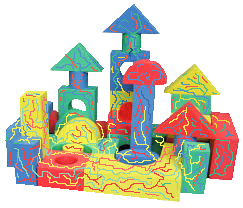
People would like to pick and chose technologies they consider good, while rejecting those they consider bad, but it’s not that easy!
James Lyman BSAE, BSEE, MSSM
From early in my youth, I’ve notice a strong tendency of people wanting to pick and choose technologies and dismiss all the rest. Here we’re particularly concerned about those technologies that take jobs. This is mostly true for those alienated in a technologically advance world, that is . . . those who haven’t advanced technologically and therefore feel they are an outsider to the world they are trying to live in. People think of technology as some set of blocks, individual blocks for individual parts of technology. Furthermore, many people feel they can pick and choose which blocks they want in their lives, and discard (ignore) the rest.
Nothing could be further from the truth!
The flaw in this thinking is that technology comes in discrete stand alone little blocks of technology unrelated to other blocks. That’s the ‘nothing could be further from the truth’ part of reality. While to the casual observer it may seem like a given technology stands alone, looking into its development and creation, we usually find a number of different technologies which come together to give the final technology. In other words, a given technology is really composed of many individual building blocks, some times hundreds if you go back far enough, that together makes the technology you see. For instances, oil . . . petroleum technology is a far reaching technology which is in 97% of everything we use in our daily lives. You wouldn’t expect oil to be in something like the nails used to build your house, but those nails were most likely ‘nailed in’ using a pneumatic nail gun, and those nails have a glue coating- and glue is made from oil.
That was the central theme of James Burke’s very popular PBS TV series ‘Connections’. In the last episode, Mr. Burke poses the question of trying to control and limit technology using different strategies. The conclusion- it’s not possible to pick and choose which technologies are good and which are bad, which will take jobs away and which will not, which are useful verses those considered bad, and then eliminating those considered bad. But these blocks of technology are not the neat orderly blocks like a child plays with. Instead, they are more like soft wax where the different colored waxes melt and flow into each other, where a filament of one color can migrate past several other blocks to fuse into a different color block.
The blocks become ill defined masses of different colors with strips of color intermingle, more a collages of colors without any readily apparent individual purposes. Blended and intertwined, it’s impossible to go in and remove a particular block, cutting out those filaments intertwined within other blocks. It only takes a few short filaments before it is impossible to separate them from the mass. For technologies, this intermixing, blending and intertwining of different technologies to give a new technology makes it even more difficult to separate and remove any technologies deemed bad, even for those well versed in science and technology. And this is for technologies already existing. Trying to determine which technology will go into a future technology that becomes a bad one is infinitely more difficult. A good example is the integrated circuit which made the digital world we now live in.
When this technology first came out, individual integrated circuits (often called chips) were unbelievable expensive. A simple four gate NAND chip that today cost just eleven cents, at first costed as much as a thousand dollars. Then America decided to go to the moon, and to go there . . . land, takeoff and rendezvous before returning to earth required a computer at a time when computers were the size of basketball courts! The only way to compress a computer down to the size and weight that could go inside a two man spaceship was by using integrated digital circuits. The result was the Apollo Guidance Computer (AGC) a 70-lb box that was 24″ x 12.5″ x 6″ that connected to the Display-Keyboard, a 17.5 lb box, 8″ x 8″ x 7″, which was used by the astronauts to operate the computer in space flight.
This miracle computer is what, more than anything else, allowed man to step onto the moon. But it had the added advantage of dropping the cost of those necessary integrated circuits (the AGC had over 4,000 of them) down first to costing dollars, then to pennies each. However, these very same chips also went into the guidance systems for an array of ICBMs so they more precisely deliver nuclear bombs onto targets. Some would therefore claim integrated circuit technology was a bad technology that should have been suppressed to prevent the proliferation of nuclear weapons. But then look at all the technologies surrounding us that wouldn’t be possible without that technology. Smart phones, personal computers, CD and DVD players . . . an array of medical instruments. Without those digital circuits, we wouldn’t have the wonders of CAT scans which is so important in saving lives by detecting and imaging diseases for treatments. Yes, the proliferation of nuclear weapons was bad, but then there was a host of life saving technologies that came out of that one technology. Whose to say which was worst?
More importantly, just how would you ever backtrack and extract that technology from a mirid of other technologies in an attempt to ‘put the toothpaste back in the tube’?
Any and every technology you look at is the same way! Each and every technology is built up on a mirid of technologies blurring together to become indistinguishable. Like the above picture, by the time you scrape out the filaments from one block, the rest looks like swiss-cheese. You don’t have anything like what you started out with. Same way with your world! By the time you eliminate those ‘job taking’ technologies you don’t want, you no longer have the world you’re blissfully living in, because you also destroy those parts you wanted to keep.
It isn’t possible to pick and choose the technologies you want in your world!
